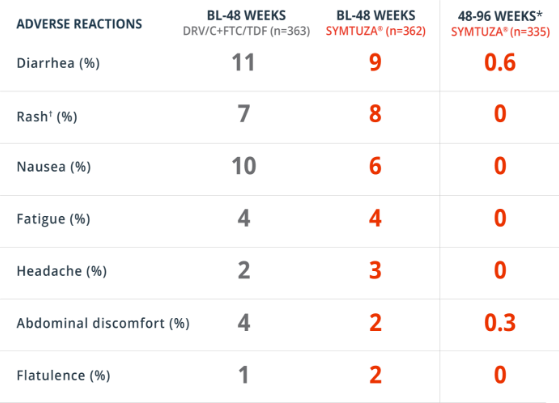IMPORTANT SAFETY INFORMATION
BOXED WARNING: POST TREATMENT ACUTE EXACERBATION OF HEPATITIS B
- Severe acute exacerbations of hepatitis B (HBV) have been reported in patients who are coinfected with HIV-1 and HBV and have discontinued products containing emtricitabine and/or tenofovir disoproxil fumarate (TDF) and may occur with discontinuation of SYMTUZA®.
Action: Monitor hepatic function with both clinical and laboratory follow-up for at least several months in patients who are coinfected with HIV-1 and HBV and discontinue SYMTUZA®. If appropriate, anti-hepatitis B therapy may be warranted.
CONTRAINDICATIONS
- Do not coadminister SYMTUZA® and the following drugs due to the potential for serious and/or life-threatening events or loss of therapeutic effect: alfuzosin, carbamazepine, colchicine (in patients with renal and/or hepatic impairment), dronedarone, elbasvir/grazoprevir, ergot derivatives (such as: dihydroergotamine, ergotamine, methylergonovine), ivabradine, lomitapide, lovastatin, lurasidone, oral midazolam, naloxegol, phenobarbital, phenytoin, pimozide, ranolazine, rifampin, St. John’s wort (Hypericum perforatum), sildenafil for pulmonary arterial hypertension, simvastatin, and triazolam.
References: 1. Data on file. Janssen Therapeutics, Division of Janssen Products, LP. 2. SYMTUZA® [package insert]. Titusville, NJ: Janssen Therapeutics, Division of Janssen Products, LP. 3. Orkin C, Eron JJ, Rockstroh J, et al; AMBER Study Group. Week 96 results of a phase 3 trial of darunavir/cobicistat/emtricitabine/tenofovir alafenamide in treatment-naive HIV-1 patients. AIDS. 2020;34(5):707-718. 4. Eron JJ, Orkin C, Cunningham D, et al; EMERALD Study Group. Week 96 efficacy and safety results of the phase 3, randomized EMERALD trial to evaluate switching from boosted-protease inhibitors plus emtricitabine/tenofovir disoproxil fumarate regimens to the once daily, single-tablet regimen of darunavir/cobicistat/emtricitabine/tenofovir alafenamide (D/C/F/TAF) in treatment-experienced, virologically-suppressed adults living with HIV-1. Antiviral Res. 2019;170:104543. 5. Orkin C, Molina JM, Negredo E, et al; EMERALD Study Group. Efficacy and safety of switching from boosted protease inhibitors plus emtricitabine and tenofovir disoproxil fumarate regimens to single-tablet darunavir, cobicistat, emtricitabine, and tenofovir alafenamide at 48 weeks in adults with virologically suppressed HIV-1 (EMERALD): a phase 3, randomised, non-inferiority trial. Lancet HIV. 2018;5(1):e23-e34. 6. Huhn GD, Crofoot G, Ramgopal M, et al. Darunavir/cobicistat/emtricitabine/tenofovir alafenamide in a rapid-initiation model of care for human immunodeficiency virus type 1 infection: primary analysis of the DIAMOND study. Clin Infect Dis. 2020;71(12):3110-3117.






